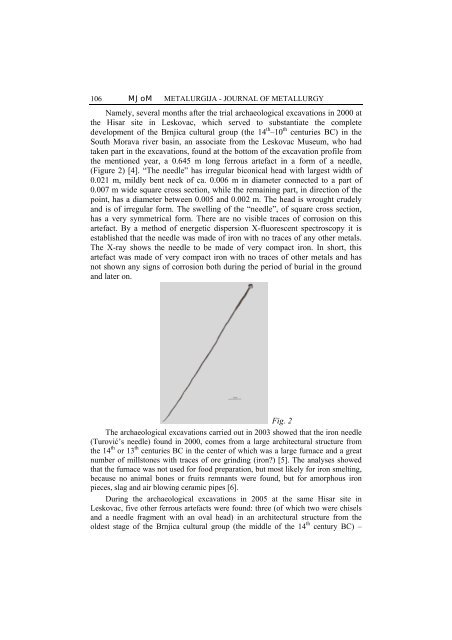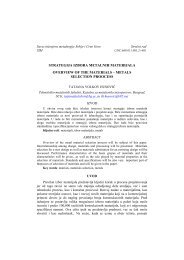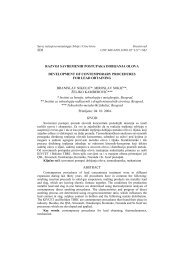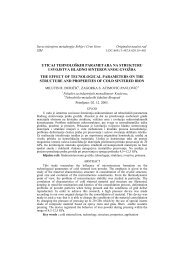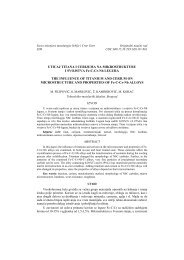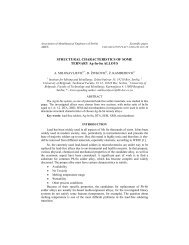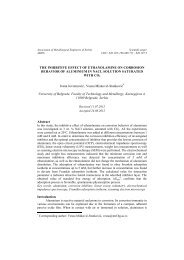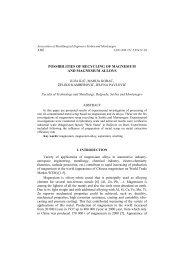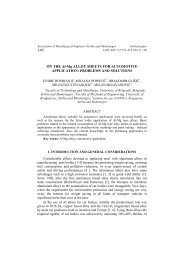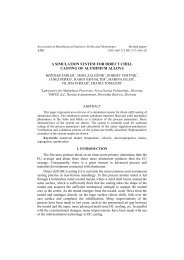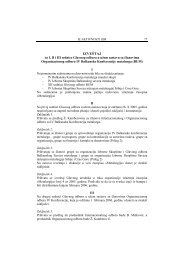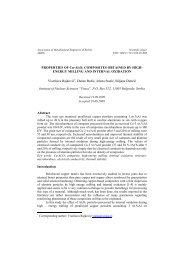ferrous metallurgy center of the brnjica cultural group - CEON
ferrous metallurgy center of the brnjica cultural group - CEON
ferrous metallurgy center of the brnjica cultural group - CEON
Create successful ePaper yourself
Turn your PDF publications into a flip-book with our unique Google optimized e-Paper software.
106<br />
MJoM<br />
METALURGIJA - JOURNAL OF METALLURGY<br />
Namely, several months after <strong>the</strong> trial archaeological excavations in 2000 at<br />
<strong>the</strong> Hisar site in Leskovac, which served to substantiate <strong>the</strong> complete<br />
development <strong>of</strong> <strong>the</strong> Brnjica <strong>cultural</strong> <strong>group</strong> (<strong>the</strong> 14 th –10 th centuries BC) in <strong>the</strong><br />
South Morava river basin, an associate from <strong>the</strong> Leskovac Museum, who had<br />
taken part in <strong>the</strong> excavations, found at <strong>the</strong> bottom <strong>of</strong> <strong>the</strong> excavation pr<strong>of</strong>ile from<br />
<strong>the</strong> mentioned year, a 0.645 m long <strong>ferrous</strong> artefact in a form <strong>of</strong> a needle,<br />
(Figure 2) [4]. “The needle” has irregular biconical head with largest width <strong>of</strong><br />
0.021 m, mildly bent neck <strong>of</strong> ca. 0.006 m in diameter connected to a part <strong>of</strong><br />
0.007 m wide square cross section, while <strong>the</strong> remaining part, in direction <strong>of</strong> <strong>the</strong><br />
point, has a diameter between 0.005 and 0.002 m. The head is wrought crudely<br />
and is <strong>of</strong> irregular form. The swelling <strong>of</strong> <strong>the</strong> “needle”, <strong>of</strong> square cross section,<br />
has a very symmetrical form. There are no visible traces <strong>of</strong> corrosion on this<br />
artefact. By a method <strong>of</strong> energetic dispersion X-fluorescent spectroscopy it is<br />
established that <strong>the</strong> needle was made <strong>of</strong> iron with no traces <strong>of</strong> any o<strong>the</strong>r metals.<br />
The X-ray shows <strong>the</strong> needle to be made <strong>of</strong> very compact iron. In short, this<br />
artefact was made <strong>of</strong> very compact iron with no traces <strong>of</strong> o<strong>the</strong>r metals and has<br />
not shown any signs <strong>of</strong> corrosion both during <strong>the</strong> period <strong>of</strong> burial in <strong>the</strong> ground<br />
and later on.<br />
Fig. 2<br />
The archaeological excavations carried out in 2003 showed that <strong>the</strong> iron needle<br />
(Turović’s needle) found in 2000, comes from a large architectural structure from<br />
<strong>the</strong> 14 th or 13 th centuries BC in <strong>the</strong> <strong>center</strong> <strong>of</strong> which was a large furnace and a great<br />
number <strong>of</strong> millstones with traces <strong>of</strong> ore grinding (iron?) [5]. The analyses showed<br />
that <strong>the</strong> furnace was not used for food preparation, but most likely for iron smelting,<br />
because no animal bones or fruits remnants were found, but for amorphous iron<br />
pieces, slag and air blowing ceramic pipes [6].<br />
During <strong>the</strong> archaeological excavations in 2005 at <strong>the</strong> same Hisar site in<br />
Leskovac, five o<strong>the</strong>r <strong>ferrous</strong> artefacts were found: three (<strong>of</strong> which two were chisels<br />
and a needle fragment with an oval head) in an architectural structure from <strong>the</strong><br />
oldest stage <strong>of</strong> <strong>the</strong> Brnjica <strong>cultural</strong> <strong>group</strong> (<strong>the</strong> middle <strong>of</strong> <strong>the</strong> 14 th century BC) –


